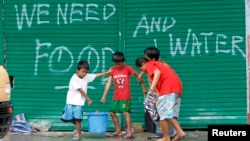GENEVA —
The United Nations is appealing for more than $301 million to provide life-saving aid to millions of victims of Typhoon Haiyan during the coming six months. The Philippines government estimates 11.3 million people in nine regions are affected by the widespread damage caused by Haiyan, the strongest typhoon to make landfall on record.
This humanitarian relief operation is huge and growing bigger by the day. The U.N. reports access to affected areas remains problematic. It says emergency services are working around the clock to remove debris from the roads and runways to allow transportation of aid.
Despite the many obstacles, aid agencies every day are flying in emergency supplies of food, clean water, medicine, tents and other shelter supplies to aid the victims. A spokeswoman for the U.N. Children’s Fund, Marixie Mercado, said no one has a full sense yet of the scale of the disaster as many areas are still out of reach.
Source: UN
“There are more than 7,000 islands in the Philippines. It is a very coastal population. Most people live on the coast," said Mercado. "It is hard to reach these people even in normal circumstances. Right now, it is that much harder. About one-third of children are malnourished in the Philippines or stunted, which means it points to a condition of chronic malnutrition. This is why it is so important that we can get safe water, hygiene items, proper sanitation, and medicine to protect children against diarrhea immediately.”
The World Food Program reports it plans to feed 2.5 million people during the next six months. But at the moment, it says distributing food to the needy is a logistical nightmare. It says roads are blocked and airports are destroyed. The U.N. food agency says it is working with the government to set up operational hubs and organize airlifts of essential supplies.
The World Health Organization says the typhoon has left health facilities damaged or completely destroyed. It says health services in the worst affected areas no longer exist or are severely stretched. It says medical supplies are in very short supply.
WHO spokesman Tarik Jasarevitch said the priority is to establish temporary medical centers to treat the overwhelming health needs. “There are people who sustained injuries, trauma, but also there are people with regular health needs. And just to give you an example, it is expected that 12,000 babies will be born in the next month in the affected area. And you can imagine pregnant women need assistance, especially in these kind of conditions.”
The World Health Organization and other aid agencies say they are concerned at reports that water borne diseases, such as dysentery and diarrhea, already are spreading.
The U.N. refugee agency is responsible for the protection of women, children and other vulnerable groups, such as the elderly, the disabled and minority groups. The UNHCR says the current situation is putting the most vulnerable at significant risk.
For instance, it notes women and children are begging on the streets for donations. This exposes them to abuse and exploitation.
This humanitarian relief operation is huge and growing bigger by the day. The U.N. reports access to affected areas remains problematic. It says emergency services are working around the clock to remove debris from the roads and runways to allow transportation of aid.
Despite the many obstacles, aid agencies every day are flying in emergency supplies of food, clean water, medicine, tents and other shelter supplies to aid the victims. A spokeswoman for the U.N. Children’s Fund, Marixie Mercado, said no one has a full sense yet of the scale of the disaster as many areas are still out of reach.
Super Typhoon Haiyan
Super Typhoon Haiyan- 10,000 people feared dead
- At least 9.8 million people affected
- About 660,000 people displaced
- 394,494 people are in evacuation centers
- 1,316 evacuation centers have been established
Source: UN
The World Food Program reports it plans to feed 2.5 million people during the next six months. But at the moment, it says distributing food to the needy is a logistical nightmare. It says roads are blocked and airports are destroyed. The U.N. food agency says it is working with the government to set up operational hubs and organize airlifts of essential supplies.
The World Health Organization says the typhoon has left health facilities damaged or completely destroyed. It says health services in the worst affected areas no longer exist or are severely stretched. It says medical supplies are in very short supply.
WHO spokesman Tarik Jasarevitch said the priority is to establish temporary medical centers to treat the overwhelming health needs. “There are people who sustained injuries, trauma, but also there are people with regular health needs. And just to give you an example, it is expected that 12,000 babies will be born in the next month in the affected area. And you can imagine pregnant women need assistance, especially in these kind of conditions.”
The World Health Organization and other aid agencies say they are concerned at reports that water borne diseases, such as dysentery and diarrhea, already are spreading.
The U.N. refugee agency is responsible for the protection of women, children and other vulnerable groups, such as the elderly, the disabled and minority groups. The UNHCR says the current situation is putting the most vulnerable at significant risk.
For instance, it notes women and children are begging on the streets for donations. This exposes them to abuse and exploitation.









